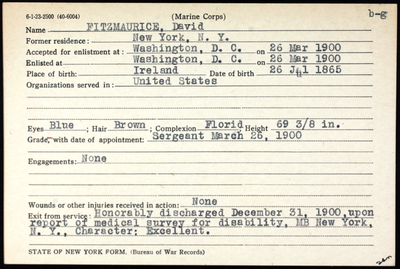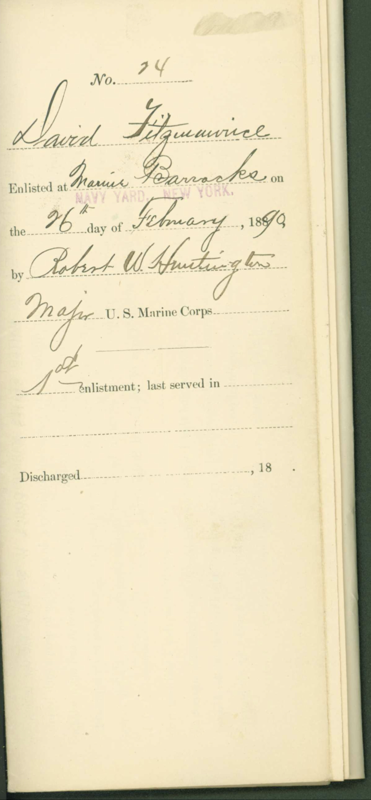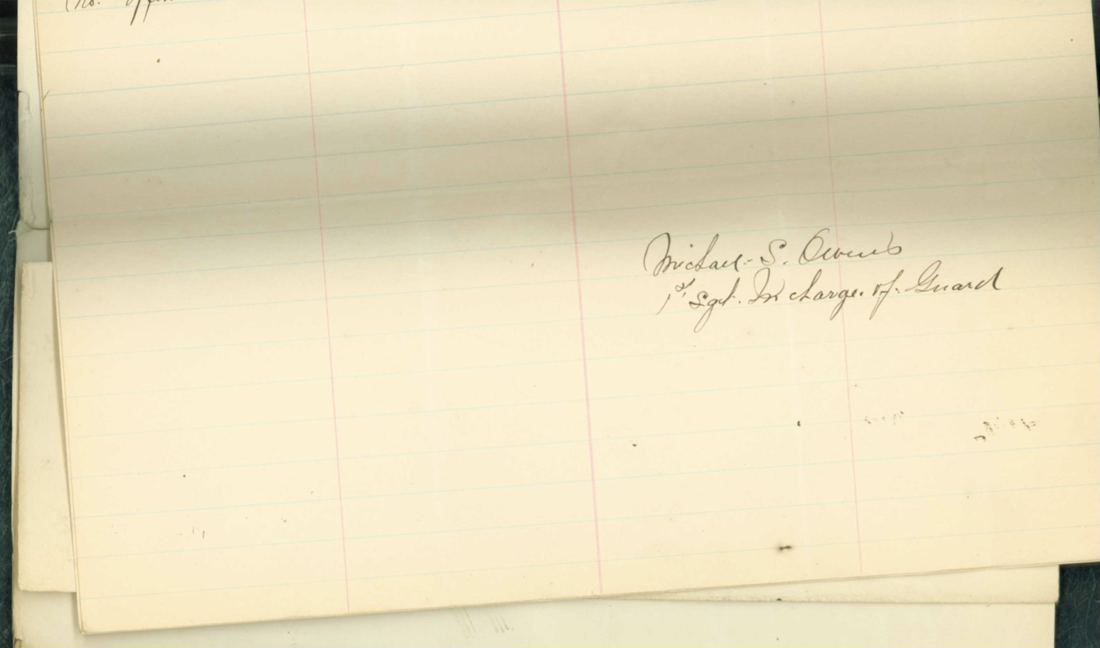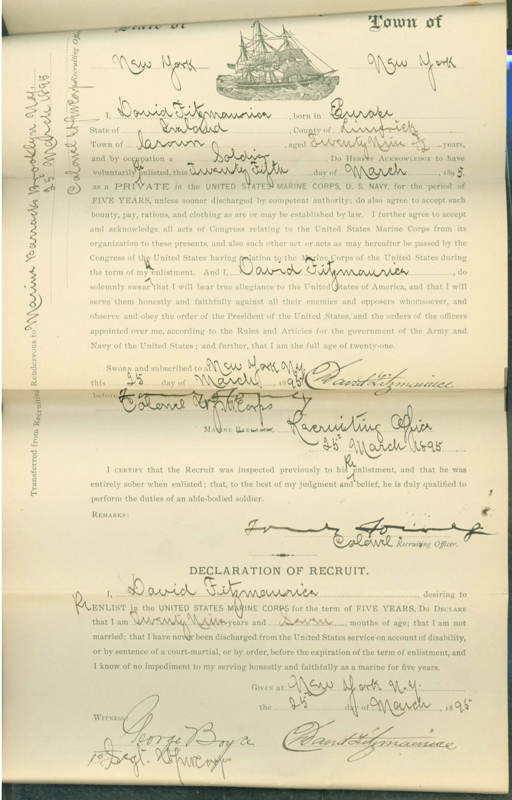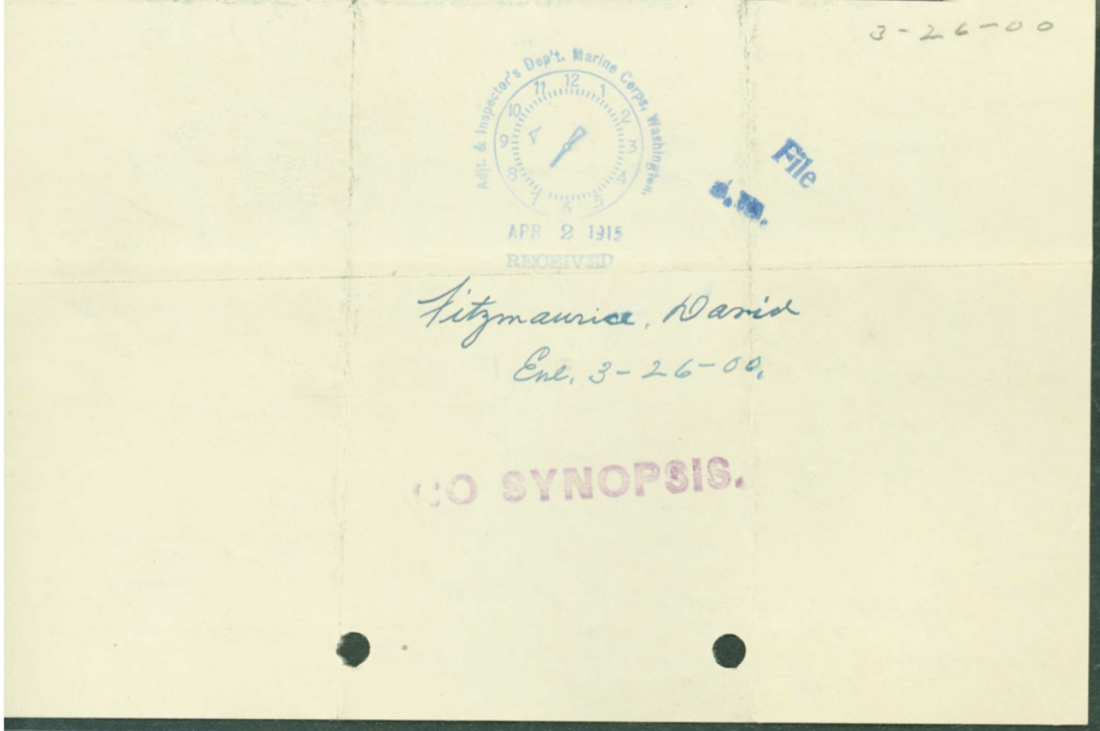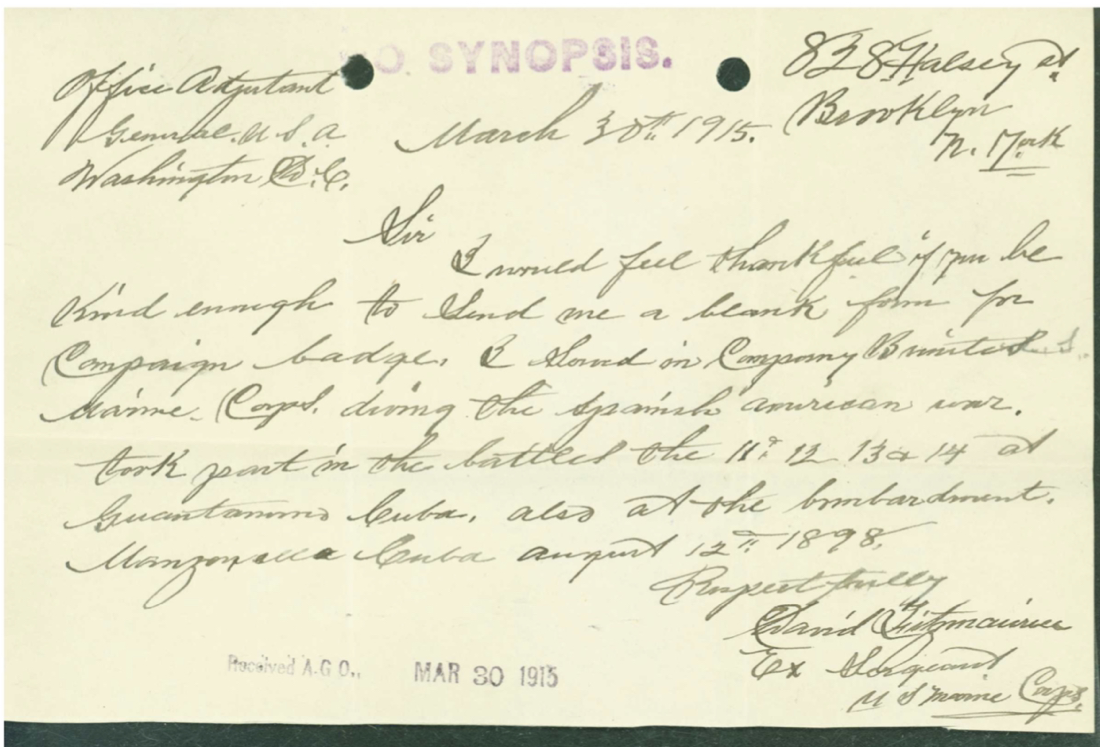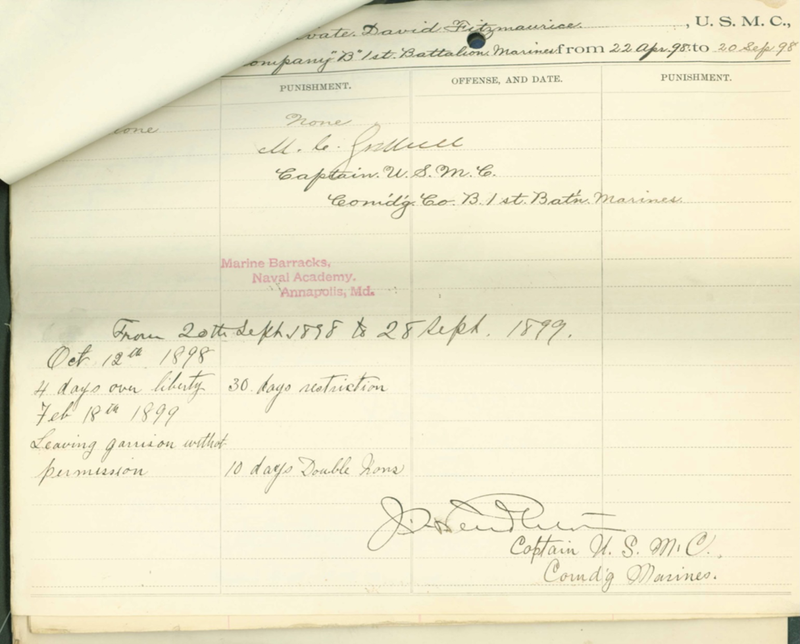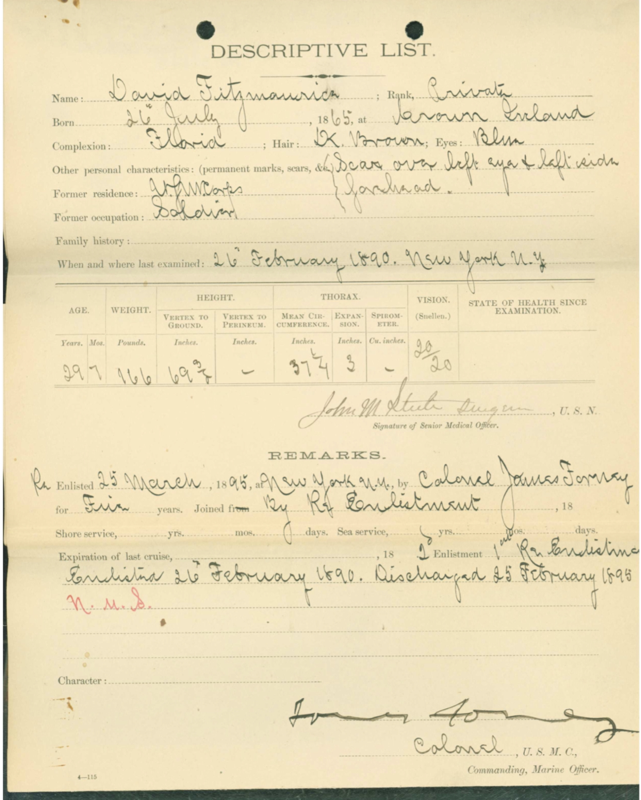United States Marine Corps Sergeant David Fitzmaurice was born March 16th 1864 in Limerick County, Croom, Ireland. David Immigrated to the United States through New York in June 1884. He worked as a Grain Miller before his military service.
David enlisted in the Marine Corps for 5 years on February 26th 1890 at the Marine Barracks, Navy Yard, Brooklyn, N.Y. where he served until he was Honorable Discharged on February 25th 1895 at Mare Island, California.
Pvt. Fitzmaurice re-enlisted March 25th 1895 at New York, N.Y. He was transferred to Annapolis, Maryland on May 14th 1895. The next year he was temporarily transferred to the SS Monongahela on May 14th 1896, and by May 27th he was back at Annapolis.
The Private was transferred to New York, N.Y. on April 19th 1898 and in just a few days he was at Camp Heywood, Portsmouth, New Hampshire waiting to depart for Cuba.
On April 22nd 1898 Pvt. Fitzmaurice along with the 1st Marine Battalion Embarked on the U.S.S. Panther. Commanded by Lieutenant Colonel Robert W. Huntington in preparation for combat operations in Cuba, sailing from Brooklyn, New York just five days later. As a converted 'banana boat', the Panther proved totally inadequate as a troop transport, and the morale of the Marines suffered in the tight and sweaty confines of the hastily converted ship as it steamed southward. As the Panther was unarmed, it was forced to stop at Hampton Roads, Virginia to obtained an armed escort before steaming to Key West, Florida, May 4th 1898 to await orders while the Marines disembarked for battalion drills, rifle practice, and route marches.
Pvt. Fitzmaurice reembarked aboard the U.S.S. Panther on June 6th as she joined the North Atlantic Fleet, portions of which blockaded Cuba throughout the conflict. Admiral William T. Sampson received word from Key West early in May that Spanish Admiral Pascual Cervera y Topete's squadron was very likely to sortie against U.S. naval forces at Santiago, Cuba. Panther and other ships of the American fleet patrolled off that port until she steamed to Guantánamo Bay with a Huntington’s battalion of 633 enlisted Marines and 24 officers.
On June 10th 1898 the Panther disembarked the First Marine Battalion at Caimanera, Guantánamo Bay, Cuba at 1:00p.m. in preparation for seizure of the harbor. During the landings, Commander Reiter of the Panther, who had continually argued over control of the Marine battalion while it was aboard ship, refused to permit the Marines to unload their small arms and artillery ammunition for their offensive, stating that he needed it for ship's ballast. He was overruled by another Navy Commander, Bowman H. McCalla, who instructed Reiter to give the Marine Lieutenant Colonel whatever he desired.
The next day June 11th through the 14th the Marines camped on the beach were under constant attacks and sniper fire, Colonel Huntington decided to attack the Spanish regular and Cuban loyalist forces. Huntington’s Marines were victorious over the 500 Spanish defenders, while suffering casualties of six killed and 16 wounded. The results left the Spanish forces entirely cut off from their fresh water supply, dramatically reducing enemy presence.
On Friday August 5th 1898, the Marine Battalion broke camp and boarded the Army transport U.S.S. Resolute. On the August 9th the ship, under convoy of the U.S.S. Newark, U.S.S. Hist, U.S.S. Osceola, U.S.S. Suwanee, and accompanied by camptured Spanish Gunboat Alvarado, departed Guantanamo Bay. The battalion’s new assignment: to capture the town of Manzanillo located on the coast northwest of Guantanamo Bay.
On Friday, August 12th, they arrived anchoring a few miles offshore. The Alvarado, under a flag of truce, was sent to demand the surrender of the town but the Spanish commander refused. The ships began a bombardment of Spanish shore batteries which ceased in the evening and resumed early the next day. At dawn white flags could be seen flying from most of Manzanillo’s buildings. A small boat was dispatched from the town, carrying a message which was delivered to Captain Goodrich aboard the U.S.S. Newark. The message stated that an armistice had been proclaimed and that the war was over.
She then set sail for the United States, reaching New York on August 23rd 1898 and after inspection continued to Portsmouth Harbor the next day, where Private Fitzmaurice and the 1st Marine Battalion disembarked and came ashore at Camp Heywood, Seavey’s Island on August 26th 1898.
Pvt. Fitzmaurice was transferred back to Annapolis, Maryland on September 20th 1898, he was then appointed Corporal the following summer on July 8th 1899. He was transferred to the Navy Yard Washington D.C. on September 28th 1899. The Corporal then made Sergeant on December 26th 1899.
Sergeant Fitzmaurice was Discharged due to expiration of Enlistment on March 24th 1900 with Character Excellent. He immediately re-enlisted March 26th 1900 at Marine Barracks, Navy Yard, Washington D.C.
On December 11th 1900 Sergeant Fitzmaurice reported to the New York Naval Hospital for a medical survey. It was discovered he suffered from Chorio Rheumation with valvular disease of the heart, origin “In line of duty” in Cuba in 1898. His condition was recorded as “unfit for service” and recommended that he was to be discharged from the Marine Corps.
Sergeant Fitzmaurice was Honorably Discharged from the Marine Corps on December 31st 1900. He spent the next 233 days in the hospital treating his illness. He was issued this Sampson Medal on December 5th 1904, as well as Spanish Campaign Medal #660 April 12th 1915
David Fitzmaurice was Naturalized as a U.S. citizen on April 19th 1906, he reported his occupation as a gardener.
United States Marine Corps Sergeant David Fitzmaurice Died March 6th 1918. He was interred at the Holy Cross Cemetery, Brooklyn, Kings County, N.Y. on August 9th 1918.
David enlisted in the Marine Corps for 5 years on February 26th 1890 at the Marine Barracks, Navy Yard, Brooklyn, N.Y. where he served until he was Honorable Discharged on February 25th 1895 at Mare Island, California.
Pvt. Fitzmaurice re-enlisted March 25th 1895 at New York, N.Y. He was transferred to Annapolis, Maryland on May 14th 1895. The next year he was temporarily transferred to the SS Monongahela on May 14th 1896, and by May 27th he was back at Annapolis.
The Private was transferred to New York, N.Y. on April 19th 1898 and in just a few days he was at Camp Heywood, Portsmouth, New Hampshire waiting to depart for Cuba.
On April 22nd 1898 Pvt. Fitzmaurice along with the 1st Marine Battalion Embarked on the U.S.S. Panther. Commanded by Lieutenant Colonel Robert W. Huntington in preparation for combat operations in Cuba, sailing from Brooklyn, New York just five days later. As a converted 'banana boat', the Panther proved totally inadequate as a troop transport, and the morale of the Marines suffered in the tight and sweaty confines of the hastily converted ship as it steamed southward. As the Panther was unarmed, it was forced to stop at Hampton Roads, Virginia to obtained an armed escort before steaming to Key West, Florida, May 4th 1898 to await orders while the Marines disembarked for battalion drills, rifle practice, and route marches.
Pvt. Fitzmaurice reembarked aboard the U.S.S. Panther on June 6th as she joined the North Atlantic Fleet, portions of which blockaded Cuba throughout the conflict. Admiral William T. Sampson received word from Key West early in May that Spanish Admiral Pascual Cervera y Topete's squadron was very likely to sortie against U.S. naval forces at Santiago, Cuba. Panther and other ships of the American fleet patrolled off that port until she steamed to Guantánamo Bay with a Huntington’s battalion of 633 enlisted Marines and 24 officers.
On June 10th 1898 the Panther disembarked the First Marine Battalion at Caimanera, Guantánamo Bay, Cuba at 1:00p.m. in preparation for seizure of the harbor. During the landings, Commander Reiter of the Panther, who had continually argued over control of the Marine battalion while it was aboard ship, refused to permit the Marines to unload their small arms and artillery ammunition for their offensive, stating that he needed it for ship's ballast. He was overruled by another Navy Commander, Bowman H. McCalla, who instructed Reiter to give the Marine Lieutenant Colonel whatever he desired.
The next day June 11th through the 14th the Marines camped on the beach were under constant attacks and sniper fire, Colonel Huntington decided to attack the Spanish regular and Cuban loyalist forces. Huntington’s Marines were victorious over the 500 Spanish defenders, while suffering casualties of six killed and 16 wounded. The results left the Spanish forces entirely cut off from their fresh water supply, dramatically reducing enemy presence.
On Friday August 5th 1898, the Marine Battalion broke camp and boarded the Army transport U.S.S. Resolute. On the August 9th the ship, under convoy of the U.S.S. Newark, U.S.S. Hist, U.S.S. Osceola, U.S.S. Suwanee, and accompanied by camptured Spanish Gunboat Alvarado, departed Guantanamo Bay. The battalion’s new assignment: to capture the town of Manzanillo located on the coast northwest of Guantanamo Bay.
On Friday, August 12th, they arrived anchoring a few miles offshore. The Alvarado, under a flag of truce, was sent to demand the surrender of the town but the Spanish commander refused. The ships began a bombardment of Spanish shore batteries which ceased in the evening and resumed early the next day. At dawn white flags could be seen flying from most of Manzanillo’s buildings. A small boat was dispatched from the town, carrying a message which was delivered to Captain Goodrich aboard the U.S.S. Newark. The message stated that an armistice had been proclaimed and that the war was over.
She then set sail for the United States, reaching New York on August 23rd 1898 and after inspection continued to Portsmouth Harbor the next day, where Private Fitzmaurice and the 1st Marine Battalion disembarked and came ashore at Camp Heywood, Seavey’s Island on August 26th 1898.
Pvt. Fitzmaurice was transferred back to Annapolis, Maryland on September 20th 1898, he was then appointed Corporal the following summer on July 8th 1899. He was transferred to the Navy Yard Washington D.C. on September 28th 1899. The Corporal then made Sergeant on December 26th 1899.
Sergeant Fitzmaurice was Discharged due to expiration of Enlistment on March 24th 1900 with Character Excellent. He immediately re-enlisted March 26th 1900 at Marine Barracks, Navy Yard, Washington D.C.
On December 11th 1900 Sergeant Fitzmaurice reported to the New York Naval Hospital for a medical survey. It was discovered he suffered from Chorio Rheumation with valvular disease of the heart, origin “In line of duty” in Cuba in 1898. His condition was recorded as “unfit for service” and recommended that he was to be discharged from the Marine Corps.
Sergeant Fitzmaurice was Honorably Discharged from the Marine Corps on December 31st 1900. He spent the next 233 days in the hospital treating his illness. He was issued this Sampson Medal on December 5th 1904, as well as Spanish Campaign Medal #660 April 12th 1915
David Fitzmaurice was Naturalized as a U.S. citizen on April 19th 1906, he reported his occupation as a gardener.
United States Marine Corps Sergeant David Fitzmaurice Died March 6th 1918. He was interred at the Holy Cross Cemetery, Brooklyn, Kings County, N.Y. on August 9th 1918.
1898 MARINE CORPS SAMPSON MEDAL
Sources:




